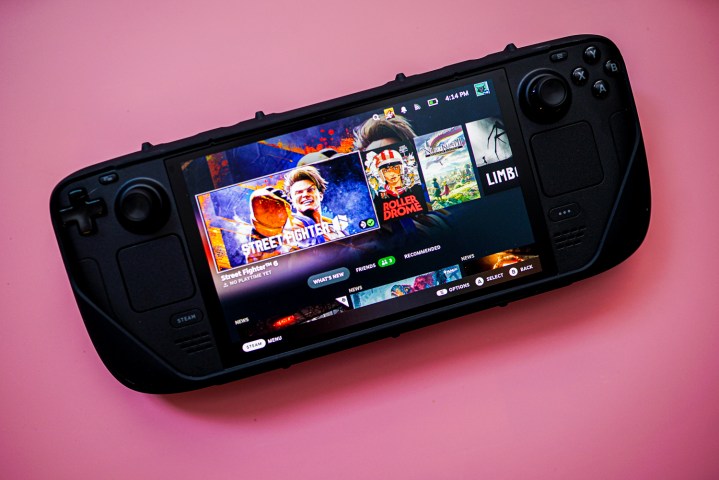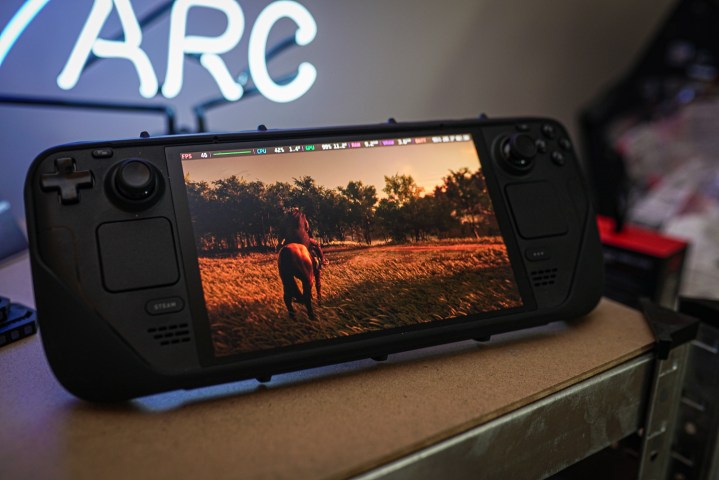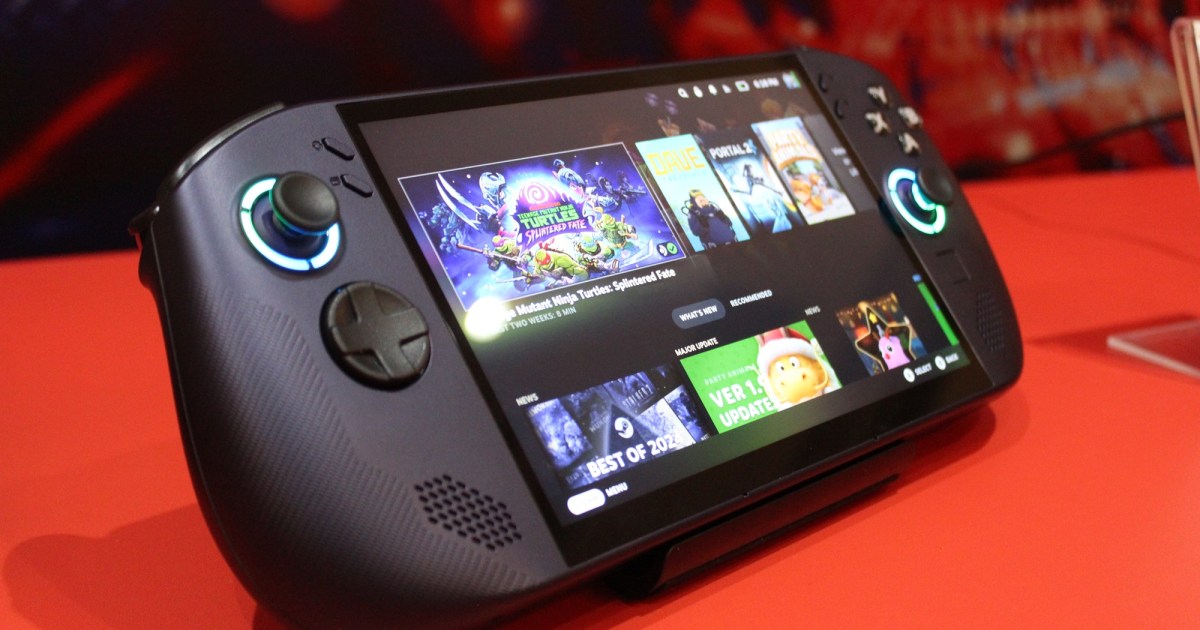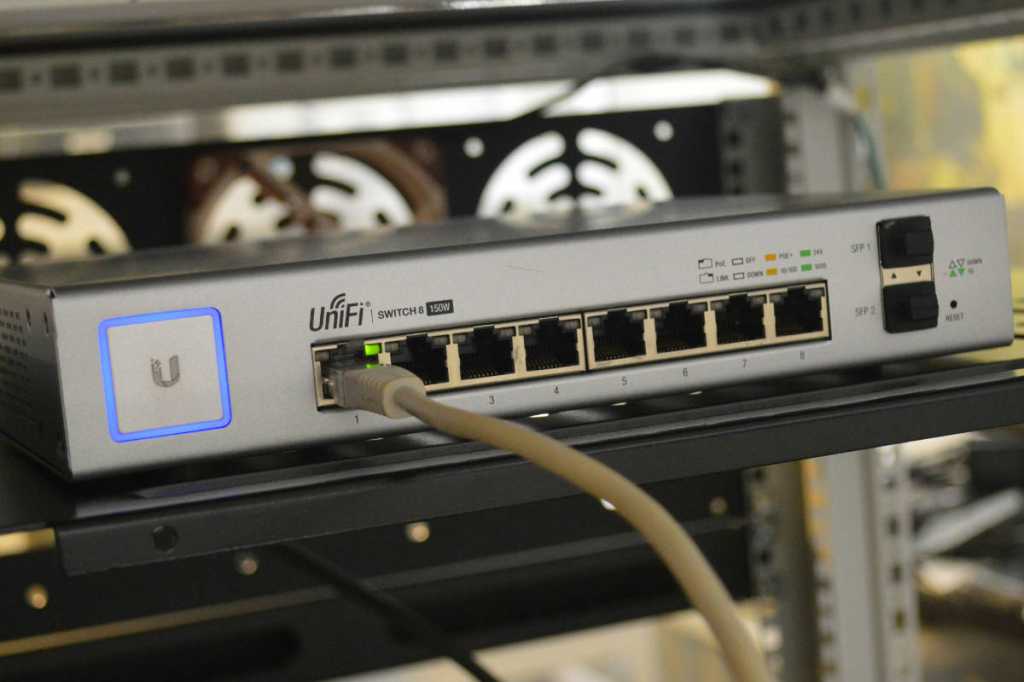The Lenovo Legion Go S has arrived, and it’s set its sights squarely on the Steam Deck. With an upgraded display, a powerful processor, and a competitive price, this new handheld PC gaming console is ready to shake up the portable gaming landscape. One of the most exciting aspects? It’s likely the first dedicated SteamOS handheld available outside of the Steam Deck, making SteamOS more accessible than ever. While comprehensive testing is still needed, we’ve gathered everything we know about the Legion Go S and how it stacks up against the Steam Deck OLED.
Price and Availability
 The Steam Deck OLED on a pink background.Price is a critical factor for portable gaming devices. They aim to provide a more affordable and convenient gaming experience compared to traditional PCs and consoles. The Legion Go S enters the market with an aggressive pricing strategy. The entry-level model, equipped with the AMD Ryzen Z2 Go chip and running SteamOS, starts at $500, undercutting the Steam Deck OLED by $50. This makes it an attractive option for budget-conscious gamers, though still more expensive than the Steam Deck’s LCD model. A more powerful Z1 Extreme configuration (and eventually a Z2 Extreme) will also be available, with pricing details yet to be announced.
The Steam Deck OLED on a pink background.Price is a critical factor for portable gaming devices. They aim to provide a more affordable and convenient gaming experience compared to traditional PCs and consoles. The Legion Go S enters the market with an aggressive pricing strategy. The entry-level model, equipped with the AMD Ryzen Z2 Go chip and running SteamOS, starts at $500, undercutting the Steam Deck OLED by $50. This makes it an attractive option for budget-conscious gamers, though still more expensive than the Steam Deck’s LCD model. A more powerful Z1 Extreme configuration (and eventually a Z2 Extreme) will also be available, with pricing details yet to be announced.
Windows 11 configurations add another layer to the pricing. The first available model is the high-end $730 Z1 Extreme running Windows 11. In May, an entry-level Windows 11 version with the same specs as the SteamOS model will launch at $530. Interestingly, there are currently no rumors of a Steam Deck 2 with a Z2 processor to compete directly with the Legion Go S’s enhanced performance.
Specs Showdown
 Legion Go S face buttons and touchpad.While specifications don’t tell the whole story, they provide a valuable starting point for comparison. Here’s how the Legion Go S measures up against the Steam Deck OLED:
Legion Go S face buttons and touchpad.While specifications don’t tell the whole story, they provide a valuable starting point for comparison. Here’s how the Legion Go S measures up against the Steam Deck OLED:
| Feature | Steam Deck OLED | Lenovo Legion Go S |
|---|---|---|
| APU | AMD Custom APU (4 Zen 2 cores/8 threads, up to 3.5GHz) | AMD Ryzen Z2 Go (4 Zen 3 cores/8 threads, up to 4.3GHz) / AMD Ryzen Z1 Extreme (8 Zen 4 cores/16 threads, up to 5.1GHz) |
| Memory | 16GB LPDDR5-6400 | 16GB LPDDR5-6400 / 32GB LPDDR5X-6400 |
| Storage | 512GB/1TB NVMe SSD | 512GB/1TB NVMe SSD |
| Screen | 7-inch 1280×800 HDR OLED, 90Hz | 8-inch 1920×1200 LCD, 120Hz, 500 nits |
| Ports | 1x USB-C, 1x microSD, 1x 3.5mm audio | 2x USB-C, 1x microSD, 1x 3.5mm audio |
| Battery | 40Wh | 49.2Wh |
| Dimensions | 11.73 x 4.6 x 1.93 inches | 11.77 x 5 x 0.89 inches |
| Weight | 1.40 pounds | 1.61 pounds |
| Price | $550/$650 | $500+ |
The Legion Go S boasts significant upgrades, particularly in processing power. The Z1 Extreme CPU stands out, offering substantially more cores and higher clock speeds than the Steam Deck’s Zen 2 APU. The Z2 Go also provides a generational leap to Zen 3 architecture. Importantly, both the Z2 Go and Z1 Extreme feature the same 12-core RDNA 3 GPU, promising comparable graphics performance.
Double the memory capacity compared to the Steam Deck should enhance future-proofing and multitasking capabilities. The Legion Go S’s display is larger, brighter, and boasts a higher refresh rate, although it utilizes LCD technology rather than the Steam Deck’s OLED. This trade-off prioritizes clarity and responsiveness over contrast and color depth. While slightly heavier, the Legion Go S is noticeably thinner, giving it a more streamlined profile.
Design and Usability
The Legion Go S adopts an integrated design, moving away from the detachable controllers of its predecessor. This results in a more comfortable and compact form factor, though initial impressions suggest it may not quite match the Steam Deck’s ergonomics.
Offering both Windows and SteamOS provides flexibility for users. The Windows version is reportedly responsive and snappy. While the Legion Go S’s touchpad is smaller than the Steam Deck’s, it remains functional for basic navigation and quick actions. The Steam Deck’s OLED panel delivers richer visuals, but the Legion Go S’s crisp 1080p, 120Hz LCD offers smoothness and clarity that could be advantageous in competitive gaming scenarios.
Performance Expectations
 Ghost of Tsushima running on the Steam Deck.Although benchmarks are pending, the Legion Go S is expected to outperform the Steam Deck, potentially by a significant margin. The newer CPU architecture, higher clock speeds, and the more powerful RDNA 3 GPU contribute to this anticipated performance advantage. The higher resolution display will demand more processing power, but the remaining headroom should translate to higher frame rates, complemented by the 120Hz refresh rate.
Ghost of Tsushima running on the Steam Deck.Although benchmarks are pending, the Legion Go S is expected to outperform the Steam Deck, potentially by a significant margin. The newer CPU architecture, higher clock speeds, and the more powerful RDNA 3 GPU contribute to this anticipated performance advantage. The higher resolution display will demand more processing power, but the remaining headroom should translate to higher frame rates, complemented by the 120Hz refresh rate.
A New Era in Handheld Gaming?
The Steam Deck, despite its age, remains a strong contender in the handheld PC gaming market. However, the Legion Go S’s superior performance, competitive pricing, and upgraded display make it a compelling alternative. While the Steam Deck retains advantages in ergonomics and OLED display quality, the Legion Go S represents a significant step forward in handheld PC gaming technology. With its various configurations and operating system options, the Legion Go S is poised to appeal to a broad audience of gamers.










